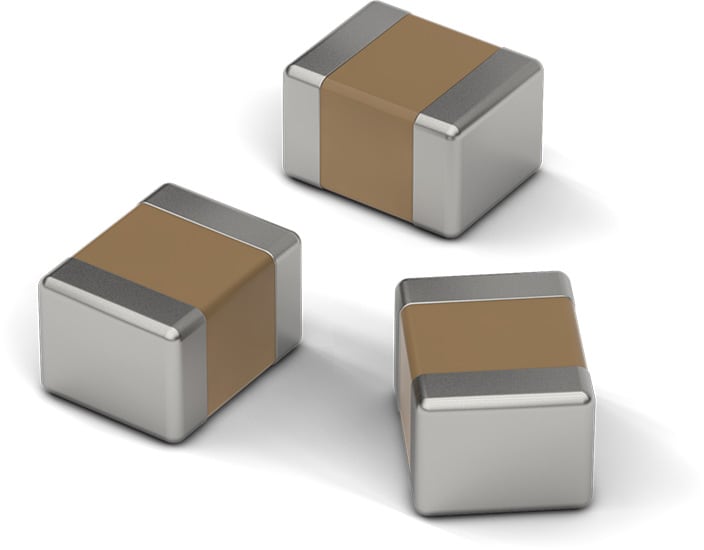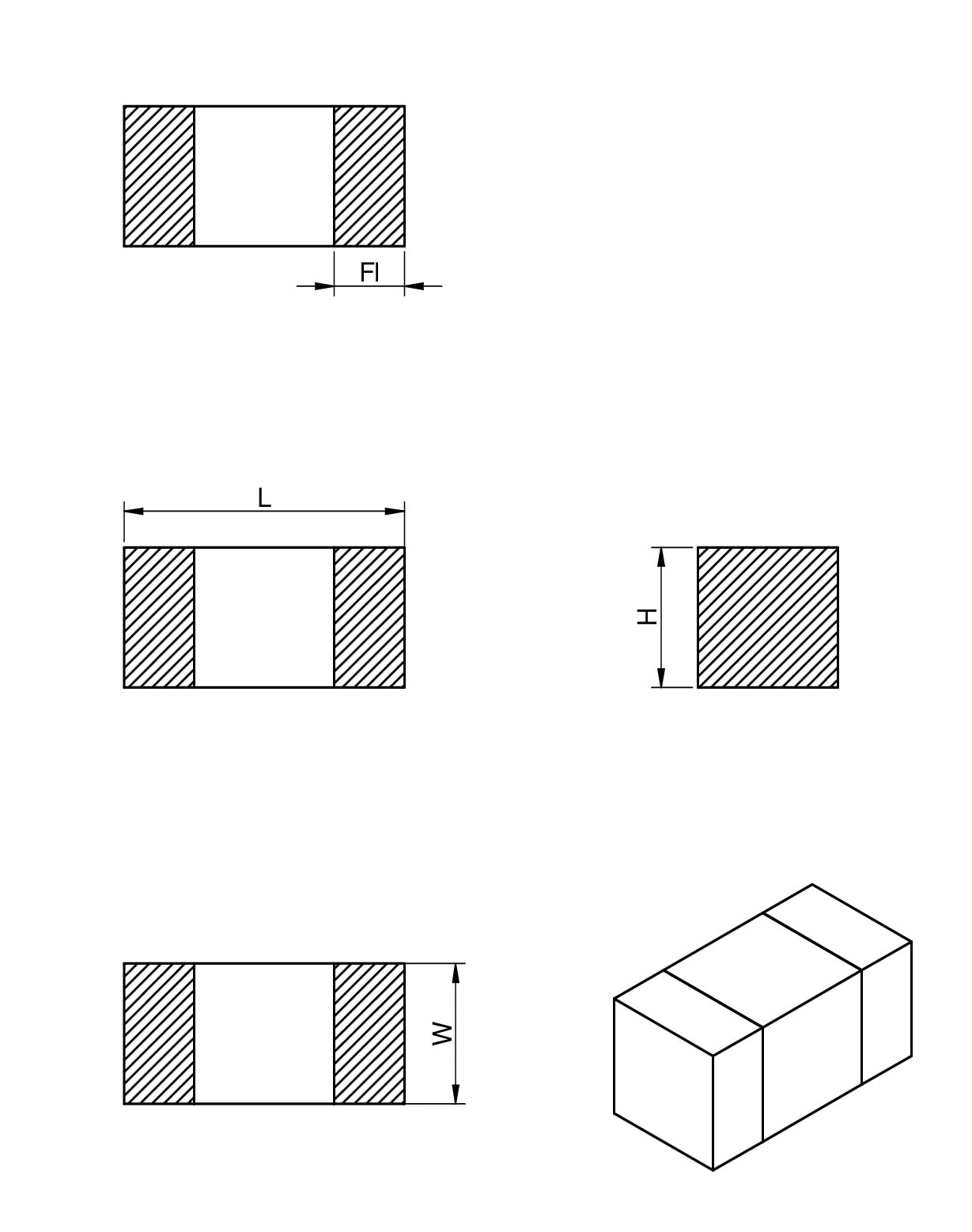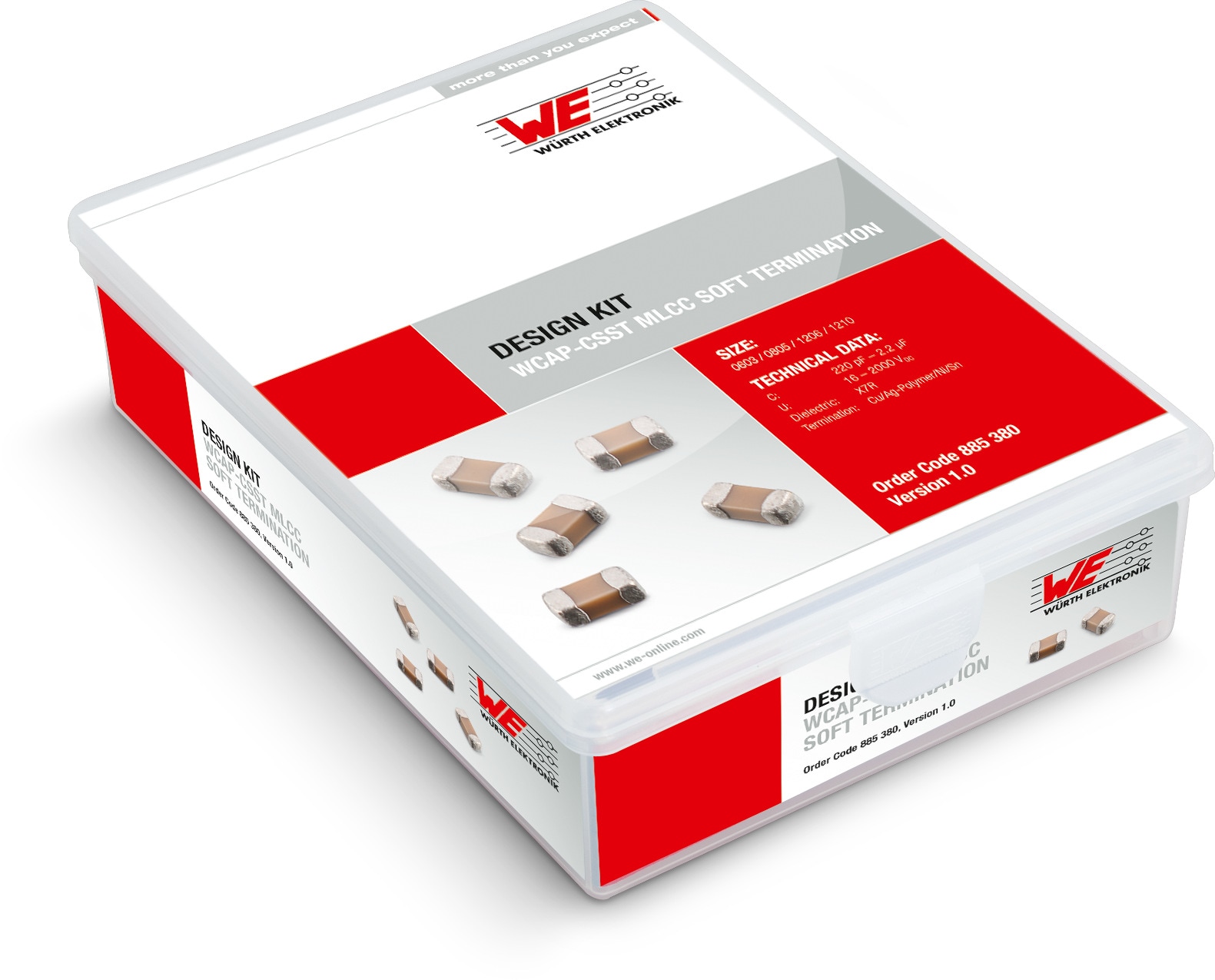LTSpice files
Characteristics
- Product series with high absorption of mechanical stress
- Mounting style: SMT-Chip
- Capacitance range: 220 pF - 2.2 µF
- Temperature Coefficient: ± 15 %
- Sizes: 0603 / 0805 / 1206 / 1210
- Termination: Ag-Polymer/Ni/Sn
- Recommended soldering: Reflow soldering
- Wave soldering (only valid for the thickness ≤0.85 mm)
Applications
- Application with high mechanical stress
- Power supply
- Lighting
Application Notes
- ANP062 LC Filter Design With MLCCs: Why The Applied Voltage Matters
- ANP098 Effect of layout, vias and design on the blocking quality of filter capacitors
- ANP109 Impedance Spectra of Different Capacitor Technologies
- ANP117 Impact of output capacitor on feedback loop stability of a power supply
- ANP123 Long- and Short-Term Voltage Dependence of Ferroelectric Class 2 MLCCs
- ANS018 EMI Filter Design for Non-Isolated DC/DC Converters
- SN011 Why does the capacity of MLCCs change
Products
All
0603
0805
1206
1210
1812
| Order Code | Datasheet | Simulation | Downloads | Status | C | Tol. C | VR (V (DC)) | Size | Operating Temperature | DF (%) | RISO | L (mm) | W (mm) | H (mm) | Fl (mm) | Ceramic Type | Packaging | Design Kit | Samples |
|---|---|---|---|---|---|---|---|---|---|---|---|---|---|---|---|---|---|---|---|
| 885382206001 | SPEC | 7 files | Active i| Production is active. Expected lifetime: >10 years. | 220 pF | ±10% | 50 | 0603 | -55 °C up to +125 °C | 2.5 | 10 GΩ | 1.6 | 0.8 | 0.8 | 0.4 | X7R Class II | 7" Tape & Reel | 885380 | ||
| 885382207010 | SPEC | 7 files | Active i| Production is active. Expected lifetime: >10 years. | 270 pF | ±10% | 500 | 0805 | -55 °C up to +125 °C | 2.5 | 10 GΩ | 2 | 1.25 | 1.25 | 0.5 | X7R Class II | 7" Tape & Reel | 885380 | ||
| 885382208008 | SPEC | 7 files | Active i| Production is active. Expected lifetime: >10 years. | 270 pF | ±10% | 500 | 1206 | -55 °C up to +125 °C | 2.5 | 10 GΩ | 3.2 | 1.6 | 1.25 | 0.6 | X7R Class II | 7" Tape & Reel | 885380 | ||
| 885382208013 | SPEC | 7 files | Active i| Production is active. Expected lifetime: >10 years. | 470 pF | ±10% | 2000 | 1206 | -55 °C up to +125 °C | 2.5 | 10 GΩ | 3.2 | 1.6 | 1.25 | 0.6 | X7R Class II | 7" Tape & Reel | 885380 | ||
| 885382208014 | SPEC | 7 files | Active i| Production is active. Expected lifetime: >10 years. | 680 pF | ±10% | 2000 | 1206 | -55 °C up to +125 °C | 2.5 | 10 GΩ | 3.2 | 1.6 | 1.25 | 0.6 | X7R Class II | 7" Tape & Reel | 885380 | ||
| 885382206005 | SPEC | 7 files | Active i| Production is active. Expected lifetime: >10 years. | 1 nF | ±10% | 200 | 0603 | -55 °C up to +125 °C | 2.5 | 10 GΩ | 1.6 | 0.8 | 0.8 | 0.4 | X7R Class II | 7" Tape & Reel | 885380 | ||
| 885382207004 | SPEC | 7 files | Active i| Production is active. Expected lifetime: >10 years. | 1 nF | ±10% | 50 | 0805 | -55 °C up to +125 °C | 2.5 | 10 GΩ | 2 | 1.25 | 1.25 | 0.5 | X7R Class II | 7" Tape & Reel | 885380 | ||
| 885382207005 | SPEC | 7 files | Active i| Production is active. Expected lifetime: >10 years. | 2.2 nF | ±10% | 50 | 0805 | -55 °C up to +125 °C | 2.5 | 10 GΩ | 2 | 1.25 | 1.25 | 0.5 | X7R Class II | 7" Tape & Reel | 885380 | ||
| 885382208012 | SPEC | 7 files | Active i| Production is active. Expected lifetime: >10 years. | 4.7 nF | ±10% | 1000 | 1206 | -55 °C up to +125 °C | 2.5 | 10 GΩ | 3.2 | 1.6 | 1.25 | 0.6 | X7R Class II | 7" Tape & Reel | 885380 | ||
| 885382206002 | SPEC | 7 files | Active i| Production is active. Expected lifetime: >10 years. | 10 nF | ±10% | 50 | 0603 | -55 °C up to +125 °C | 2.5 | 10 GΩ | 1.6 | 0.8 | 0.8 | 0.4 | X7R Class II | 7" Tape & Reel | 885380 | ||
| 885382207006 | SPEC | 7 files | Active i| Production is active. Expected lifetime: >10 years. | 10 nF | ±10% | 50 | 0805 | -55 °C up to +125 °C | 2.5 | 10 GΩ | 2 | 1.25 | 1.25 | 0.5 | X7R Class II | 7" Tape & Reel | 885380 | ||
| 885382207009 | SPEC | 7 files | Active i| Production is active. Expected lifetime: >10 years. | 10 nF | ±10% | 100 | 0805 | -55 °C up to +125 °C | 2.5 | 10 GΩ | 2 | 1.25 | 1.25 | 0.5 | X7R Class II | 7" Tape & Reel | 885380 | ||
| 885382208002 | SPEC | 7 files | Active i| Production is active. Expected lifetime: >10 years. | 10 nF | ±10% | 50 | 1206 | -55 °C up to +125 °C | 2.5 | 10 GΩ | 3.2 | 1.6 | 1.25 | 0.6 | X7R Class II | 7" Tape & Reel | 885380 | ||
| 885382208009 | SPEC | 7 files | Active i| Production is active. Expected lifetime: >10 years. | 10 nF | ±10% | 500 | 1206 | -55 °C up to +125 °C | 2.5 | 10 GΩ | 3.2 | 1.6 | 1.25 | 0.6 | X7R Class II | 7" Tape & Reel | 885380 | ||
| 885382206003 | SPEC | 7 files | Active i| Production is active. Expected lifetime: >10 years. | 22 nF | ±10% | 50 | 0603 | -55 °C up to +125 °C | 2.5 | 10 GΩ | 1.6 | 0.8 | 0.8 | 0.4 | X7R Class II | 7" Tape & Reel | 885380 | ||
| 885382208010 | SPEC | 7 files | Active i| Production is active. Expected lifetime: >10 years. | 22 nF | ±10% | 500 | 1206 | -55 °C up to +125 °C | 2.5 | 4.5 GΩ | 3.2 | 1.6 | 1.6 | 0.6 | X7R Class II | 7" Tape & Reel | 885380 | ||
| 885382208011 | SPEC | 7 files | Active i| Production is active. Expected lifetime: >10 years. | 33 nF | ±10% | 500 | 1206 | -55 °C up to +125 °C | 2.5 | 3 GΩ | 3.2 | 1.6 | 1.6 | 0.6 | X7R Class II | 7" Tape & Reel | 885380 | ||
| 885382209001 | SPEC | 7 files | Active i| Production is active. Expected lifetime: >10 years. | 33 nF | ±10% | 500 | 1210 | -55 °C up to +125 °C | 2.5 | 3 GΩ | 3.2 | 2.5 | 1.6 | 0.75 | X7R Class II | 7" Tape & Reel | 885380 | ||
| 885382206004 | SPEC | 7 files | Active i| Production is active. Expected lifetime: >10 years. | 100 nF | ±10% | 50 | 0603 | -55 °C up to +125 °C | 3 | 5 GΩ | 1.6 | 0.8 | 0.8 | 0.4 | X7R Class II | 7" Tape & Reel | 885380 | ||
| 885382207007 | SPEC | 7 files | Active i| Production is active. Expected lifetime: >10 years. | 100 nF | ±10% | 50 | 0805 | -55 °C up to +125 °C | 2.5 | 5 GΩ | 2 | 1.25 | 1.25 | 0.5 | X7R Class II | 7" Tape & Reel | 885380 | ||
| 885382208003 | SPEC | 7 files | Active i| Production is active. Expected lifetime: >10 years. | 100 nF | ±10% | 50 | 1206 | -55 °C up to +125 °C | 2.5 | 5 GΩ | 3.2 | 1.6 | 1.25 | 0.6 | X7R Class II | 7" Tape & Reel | 885380 | ||
| 885382208006 | SPEC | 7 files | Active i| Production is active. Expected lifetime: >10 years. | 100 nF | ±10% | 100 | 1206 | -55 °C up to +125 °C | 2.5 | 1 GΩ | 3.2 | 1.6 | 1.25 | 0.6 | X7R Class II | 7" Tape & Reel | 885380 | ||
| 885382208007 | SPEC | 7 files | Active i| Production is active. Expected lifetime: >10 years. | 100 nF | ±10% | 250 | 1206 | -55 °C up to +125 °C | 2.5 | 1 GΩ | 3.2 | 1.6 | 1.6 | 0.6 | X7R Class II | 7" Tape & Reel | 885380 | ||
| 885382211002 | SPEC | 8 files | Active i| Production is active. Expected lifetime: >10 years. | 100 nF | ±10% | 1000 | 1812 | -55 °C up to +125 °C | 2.5 | 1 GΩ | 4.5 | 3.2 | 2.5 | 0.5 | X7R Class II | 7" Tape & Reel | – | ||
| 885382207008 | SPEC | 7 files | Active i| Production is active. Expected lifetime: >10 years. | 220 nF | ±10% | 50 | 0805 | -55 °C up to +125 °C | 3 | 2.3 GΩ | 2 | 1.25 | 1.25 | 0.5 | X7R Class II | 7" Tape & Reel | 885380 | ||
| 885382207002 | SPEC | 7 files | Active i| Production is active. Expected lifetime: >10 years. | 330 nF | ±10% | 25 | 0805 | -55 °C up to +125 °C | 3.5 | 1.5 GΩ | 2 | 1.25 | 1.25 | 0.5 | X7R Class II | 7" Tape & Reel | 885380 | ||
| 885382208004 | SPEC | 7 files | Active i| Production is active. Expected lifetime: >10 years. | 470 nF | ±10% | 50 | 1206 | -55 °C up to +125 °C | 3 | 1 GΩ | 3.2 | 1.6 | 1.6 | 0.6 | X7R Class II | 7" Tape & Reel | 885380 | ||
| 885382211003 | SPEC | 5 files | Active i| Production is active. Expected lifetime: >10 years. | 470 nF | ±10% | 500 | 1812 | -55 °C up to +125 °C | 2.5 | 0.2 GΩ | 4.5 | 3.2 | 2.5 | 0.5 | X7R Class II | 7" Tape & Reel | – | ||
| 885382207001 | SPEC | 7 files | Active i| Production is active. Expected lifetime: >10 years. | 1 µF | ±10% | 16 | 0805 | -55 °C up to +125 °C | 5 | 0.5 GΩ | 2 | 1.25 | 1.25 | 0.5 | X7R Class II | 7" Tape & Reel | 885380 | ||
| 885382207003 | SPEC | 7 files | Active i| Production is active. Expected lifetime: >10 years. | 1 µF | ±10% | 25 | 0805 | -55 °C up to +125 °C | 5 | 0.5 GΩ | 2 | 1.25 | 1.25 | 0.5 | X7R Class II | 7" Tape & Reel | 885380 | ||
| 885382208005 | SPEC | 7 files | Active i| Production is active. Expected lifetime: >10 years. | 1 µF | ±10% | 50 | 1206 | -55 °C up to +125 °C | 3 | 0.5 GΩ | 3.2 | 1.6 | 1.6 | 0.6 | X7R Class II | 7" Tape & Reel | 885380 | ||
| 885382208001 | SPEC | 7 files | Active i| Production is active. Expected lifetime: >10 years. | 2.2 µF | ±10% | 25 | 1206 | -55 °C up to +125 °C | 3.5 | 0.2 GΩ | 3.2 | 1.6 | 1.6 | 0.6 | X7R Class II | 7" Tape & Reel | 885380 | ||
| 885382209002 | SPEC | 7 files | Active i| Production is active. Expected lifetime: >10 years. | 2.2 µF | ±10% | 100 | 1210 | -55 °C up to +125 °C | 5 | 0.05 GΩ | 3.2 | 2.5 | 2.5 | 0.75 | X7R Class II | 7" Tape & Reel | 885380 | ||
| 885382208016 | SPEC | 5 files | Active i| Production is active. Expected lifetime: >10 years. | 2.2 µF | ±10% | 100 | 1206 | -55 °C up to +125 °C | 5 | 0.05 GΩ | 3.2 | 1.6 | 1.6 | 0.6 | X7R Class II | 7" Tape & Reel | – |
| Order Code | Datasheet | Simulation |
|---|---|---|
| 885382206001 | SPEC | |
| 885382207010 | SPEC | |
| 885382208008 | SPEC | |
| 885382208013 | SPEC | |
| 885382208014 | SPEC | |
| 885382206005 | SPEC | |
| 885382207004 | SPEC | |
| 885382207005 | SPEC | |
| 885382208012 | SPEC | |
| 885382206002 | SPEC | |
| 885382207006 | SPEC | |
| 885382207009 | SPEC | |
| 885382208002 | SPEC | |
| 885382208009 | SPEC | |
| 885382206003 | SPEC | |
| 885382208010 | SPEC | |
| 885382208011 | SPEC | |
| 885382209001 | SPEC | |
| 885382206004 | SPEC | |
| 885382207007 | SPEC | |
| 885382208003 | SPEC | |
| 885382208006 | SPEC | |
| 885382208007 | SPEC | |
| 885382211002 | SPEC | |
| 885382207008 | SPEC | |
| 885382207002 | SPEC | |
| 885382208004 | SPEC | |
| 885382211003 | SPEC | |
| 885382207001 | SPEC | |
| 885382207003 | SPEC | |
| 885382208005 | SPEC | |
| 885382208001 | SPEC | |
| 885382209002 | SPEC | |
| 885382208016 | SPEC |
| Samples |
|---|
| Order Code | Datasheet | Simulation | Downloads | Status | C | Tol. C | VR (V (DC)) | Size | Operating Temperature | DF (%) | RISO | L (mm) | W (mm) | H (mm) | Fl (mm) | Ceramic Type | Packaging | Design Kit | Samples |
|---|
Assortments
Articles from this product series can be found in the following assortments:
Videos
#askLorandt explains: What miniaturization means for MLCCs and what alternatives are possible
Videos
#askLorandt explains: Influence of DC-Bias on Ceramic Filter Capacitors
Videos
#askLorandt explains: LTspice DC-Bias Simulation for Capacitors
Videos
#askLorandt explains: DC/DC Converter Voltage Ripple vs. ESR of Different Capacitor Technologies
Videos
How to choose the right capacitor type for a circuit?! || Film vs. Ceramic vs. Electrolytic
Videos
Webinar: Introduction to the capacitor technologies and how to use them


